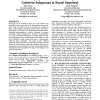Free Online Productivity Tools
i2Speak
i2Symbol
i2OCR
iTex2Img
iWeb2Print
iWeb2Shot
i2Type
iPdf2Split
iPdf2Merge
i2Bopomofo
i2Arabic
i2Style
i2Image
i2PDF
iLatex2Rtf
Sci2ools
81
Voted
HT
2007
ACM
2007
ACM
Identifying subcommunities using cohesive subgroups in social hypertext
Web pages can be modeled as nodes in a social network, and hyperlinks between pages form links (relationships) between the nodes. Links may take the form of comments, for example on blogs, creating explicit connections between authors and readers. In this paper, we describe a novel methodology and framework for identifying subcommunities as cohesive subgroups of n-cliques and k-plexes within social hypertext. We apply our methodology to a group of computer technologists in Toronto called TorCamp who communicate using a Google group. K-plex analysis is then used to identify a group of people that forms a subcommunity within the larger community. The results are then validated against the experienced sense of community of people inside and outside the subcommunity. Statistically significant differences in experienced sense of community are found, with people within the subcommunity showing higher levels of perceived influence and emotional connection. Categories and Subject Descriptors
| Added | 16 Aug 2010 |
| Updated | 16 Aug 2010 |
| Type | Conference |
| Year | 2007 |
| Where | HT |
| Authors | Alvin Chin, Mark H. Chignell |
Comments (0)

